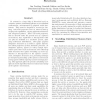Free Online Productivity Tools
i2Speak
i2Symbol
i2OCR
iTex2Img
iWeb2Print
iWeb2Shot
i2Type
iPdf2Split
iPdf2Merge
i2Bopomofo
i2Arabic
i2Style
i2Image
i2PDF
iLatex2Rtf
Sci2ools
COLCOM
2005
IEEE
2005
IEEE
Matching distributed systems to their environment using dissipative structures
In contrast to a large body of theoretical work on computer systems, distributed systems are not idealised constructions, unconstrained by physical world limitations. They must be designed to account for limiting, real-world properties such as network latency, varying node capabilities, varying application behaviour and unexpected failures. These real-world properties, that we describe under the general area of a system’s environment, have regularities or heterogeneities that can often be modelled as a stochastic process, often using well-known distributions. This paper proposes dissipative structures as a model to capture information about properties of these stochastic processes. In dissipative systems, agents (or nodes) sample information from their local environments and collectively build structures that capture knowledge of recent regularities or heterogeneities in the system’s environment. Dissipative structures are a promising technique for transferring knowledge of the sy...
Related Content
| Added | 24 Jun 2010 |
| Updated | 24 Jun 2010 |
| Type | Conference |
| Year | 2005 |
| Where | COLCOM |
| Authors | Jim Dowling, Dominik Dahlem, Jan Sacha |
Comments (0)

